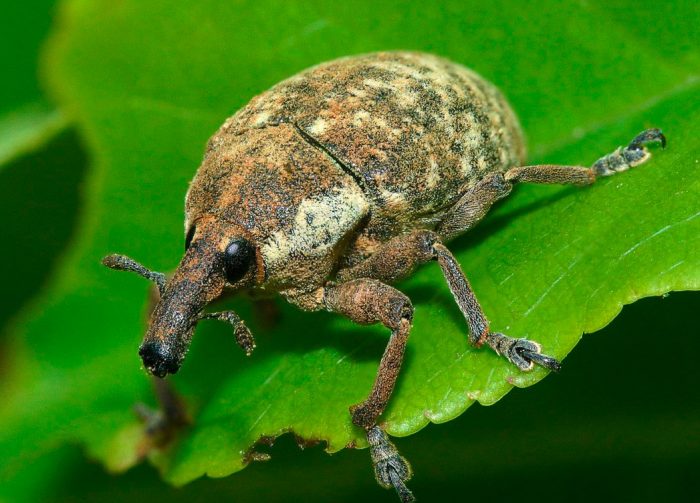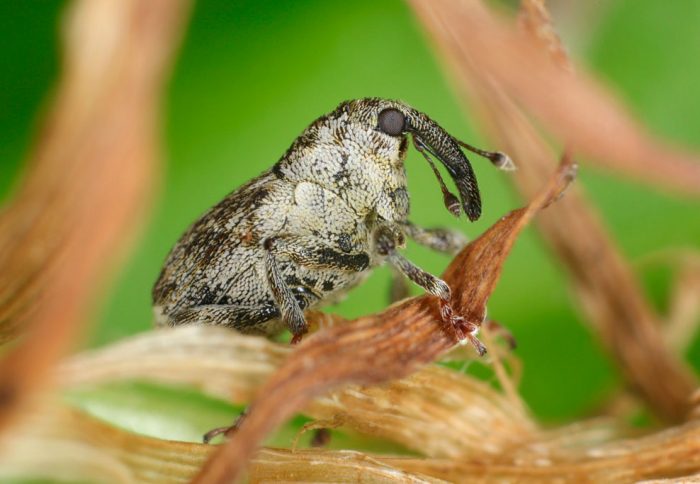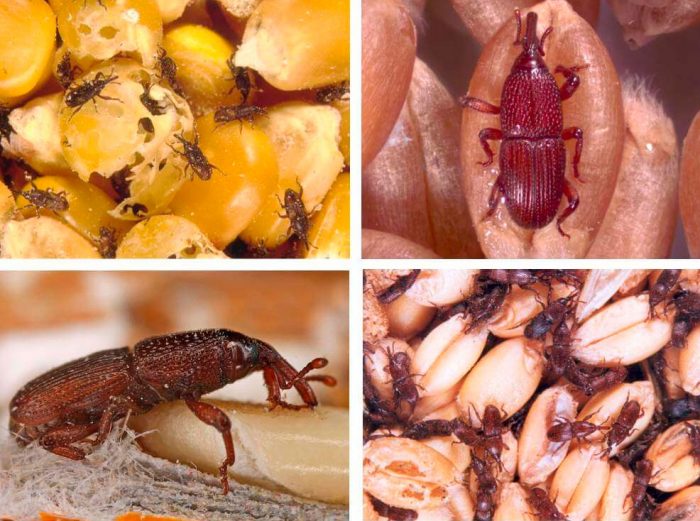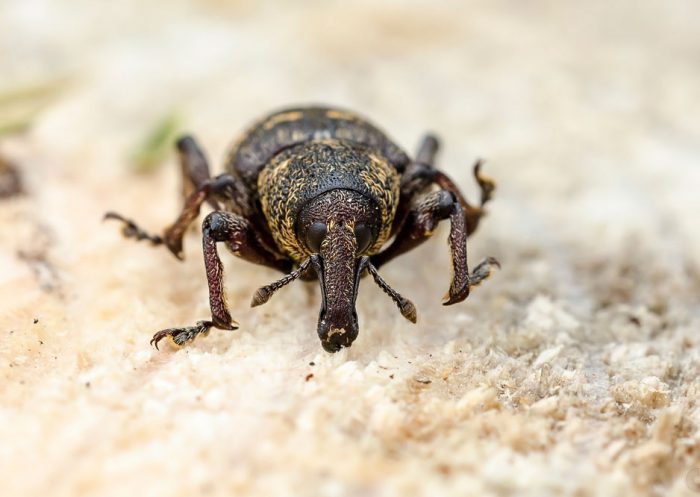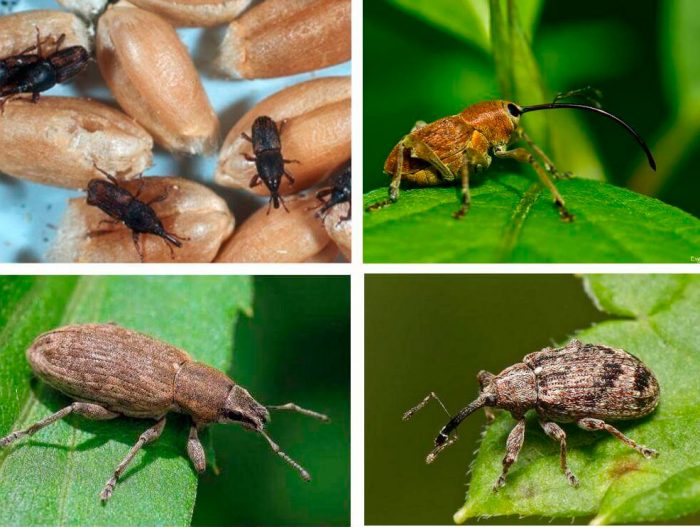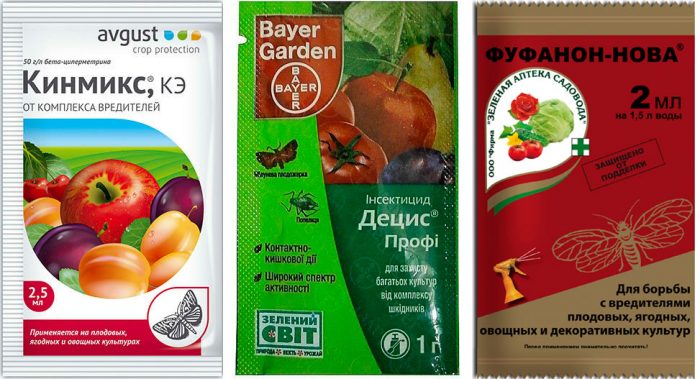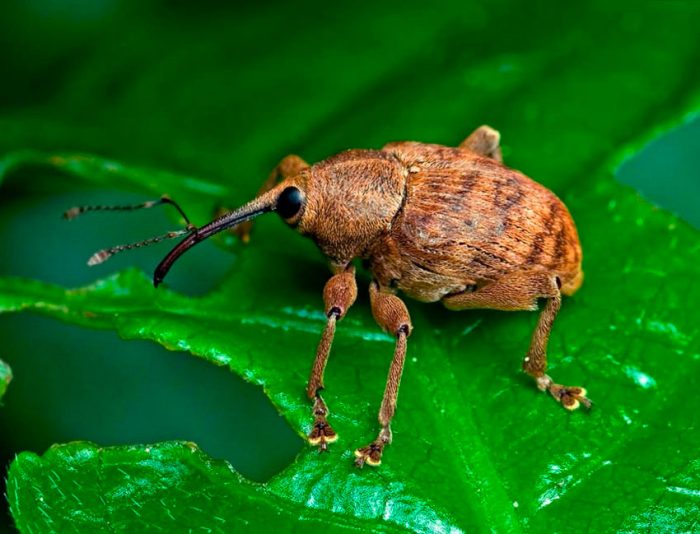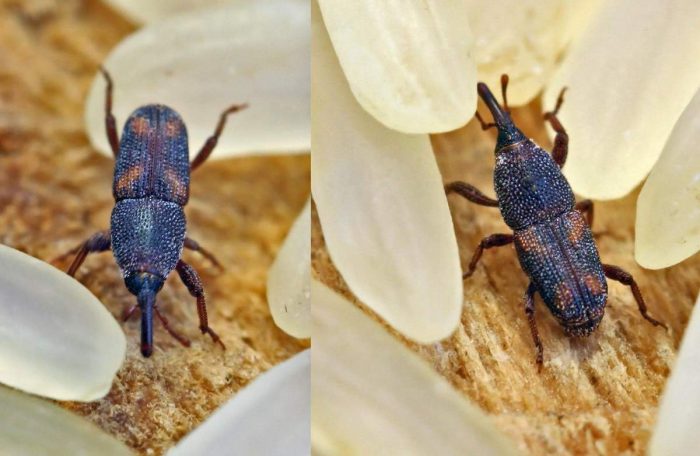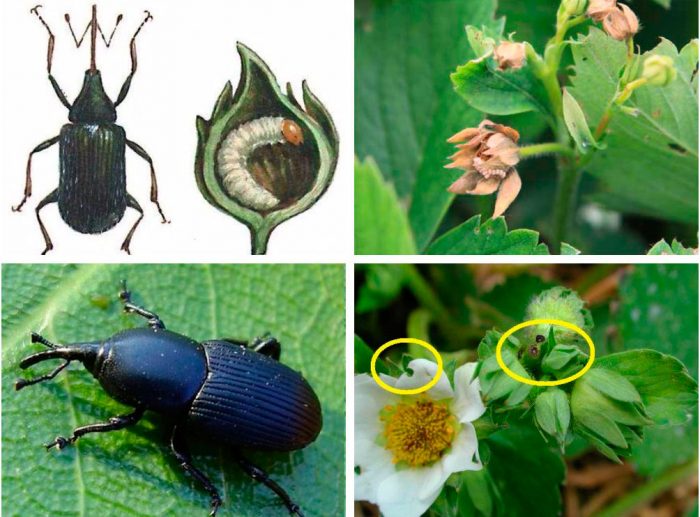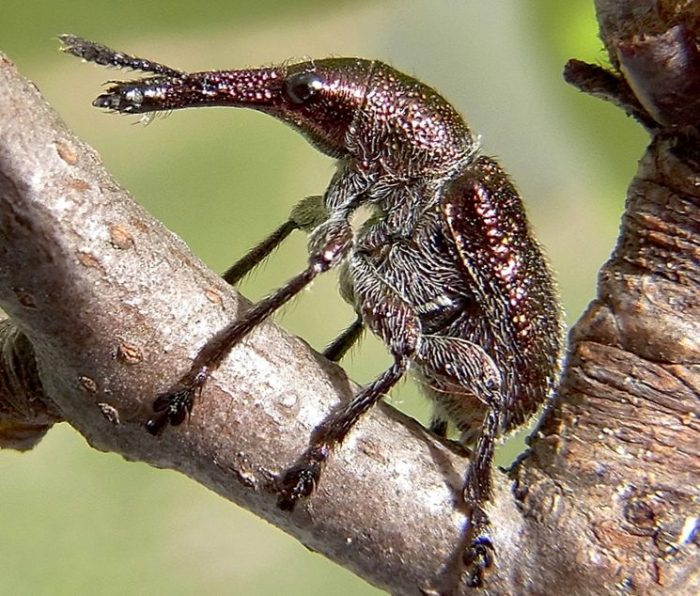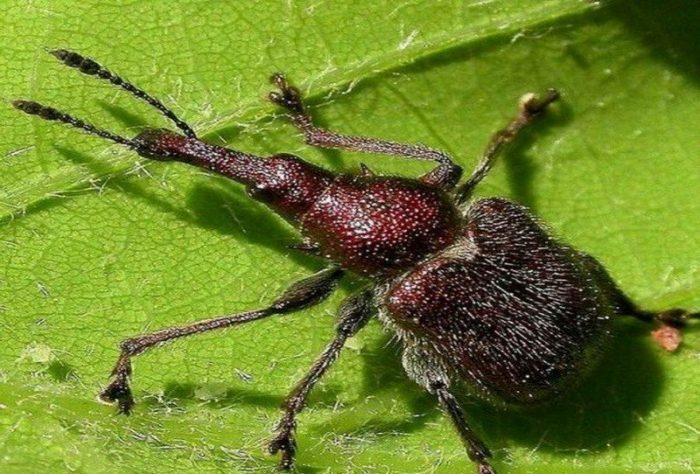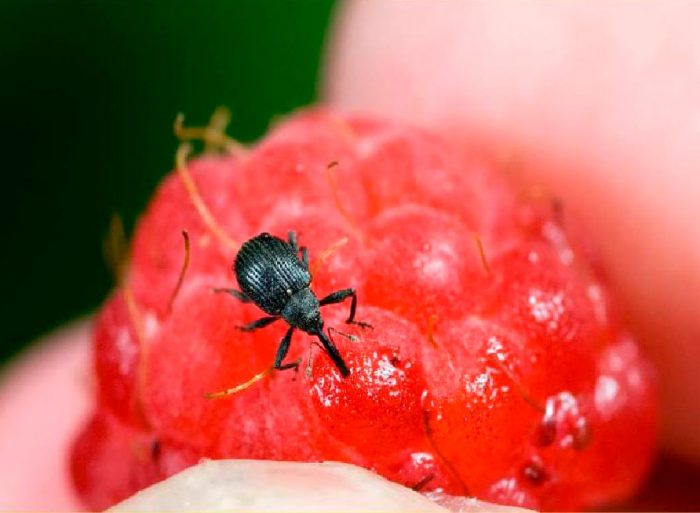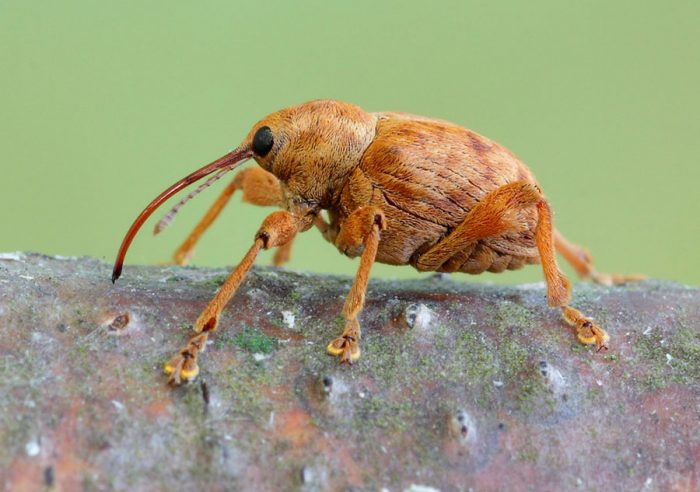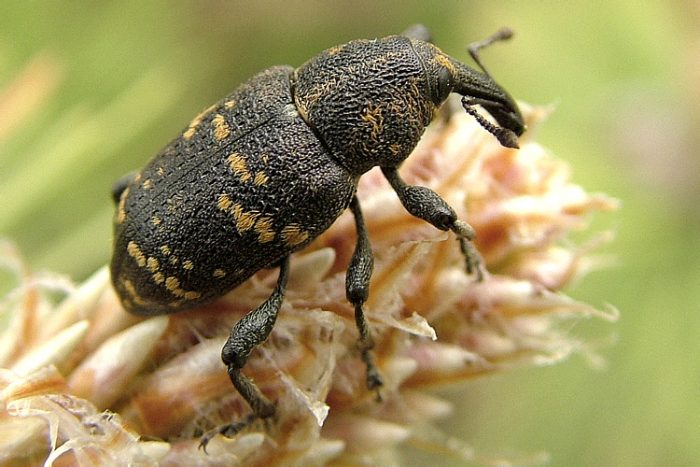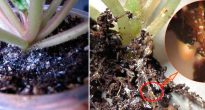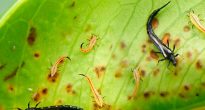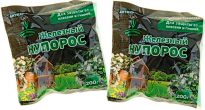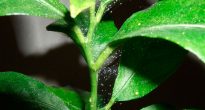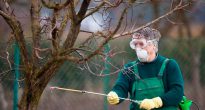The weevil beetle (Curcullionidae), also called the elephant, is a representative of a very large family, which has more than 70 thousand species, most of which can be found in the tropics. In middle latitudes, only about 5 thousand species are found. Weevils are considered pests of various plants. Interestingly, each species has its own preferences, for example, one of them damages garden crops, the other damages forest plants, the third damages garden plants, and so on. And there is also a type of beetle that damages the growth point of a palm tree, because of which it dies.
Content
Weevil features
In length, weevils can reach 0.1-3 centimeters, and tropical species sometimes grow up to 5 centimeters. In such pests, the body shape can be very different, for example: oblong, rod-shaped, spherical, pear-shaped, flat, cylindrical, rhombic, or convex hemispherical. The color varies from black to yellow, sometimes there are specks on the body, and it can also have a metallic sheen. The body of the pest can be painted in one color shade, and its legs in another. The upper part of the body is either naked or hairy, it can be covered with glazed brown scales or an earthen crust. The weevil has a characteristic feature - an elongated front part of the head (rostrum), it was she who influenced the formation of the name of this genus of insects.
All species are divided into 2 subspecies - long-probed and short-probed, which differ from each other in the length of the rostrum. In short-probed species, the larvae are in the ground and eat the roots of plants, and in long-probed species, they usually live in the tissues of various plants and feed on them. Weevil species found in middle latitudes most often settle on berry crops, while attracting their flower buds, in which the female arranges egg-laying. After their appearance, the larvae begin to eat the flower from the inside. In this regard, if there are too many pests, then the gardener may not see the berries at all. Even in the middle lane, you can meet a barn or home weevil.
Barn weevil
The barn weevil is a small beetle of dark brown color with underdeveloped wings, it reaches up to 0.4 cm in length. This pest is of particular danger to grain crops.Archaeologists have found that such a pest has existed for a very long time. In the twentieth century, in the excavations of ancient Egyptian burials, traces of a weevil were found, while in Ancient Rome this beetle was also known, and it was called Curculio there.
Adults damage grain, as well as products made from it. At the same time, in one oviposition, laid by a female, there can be about 300 eggs, the larvae that emerge from them develop in grains of wheat, oats, buckwheat, millet, rice (rice weevil), barley and rye. The pest can also live in flour and pasta. If such a pest appears in the grain, then it becomes unusable. The fact is that if you eat it, then it will cause digestive upset, since it becomes hygroscopic and by itself begins to heat up and rot.
Home weevil
The weevil in the house is the same barn weevil in the grain, but it gets into the apartment along with the cereals brought from the store. An adult female gnaws a cave in a grain and lays only one egg in it, after which she clogs up the hole with her own secretions. After 6–12 days, a larva is born, it eats up the inner part of the grain, after which it gnaws the shell and gets out. The fight against weevils is complicated by the fact that the larva inside the grain is rather difficult to detect. However, nevertheless, various ways have been invented to combat such a pest.
How to get rid of weevils
To get rid of the weevil, which is a polyphagous and very dangerous harmful insect, you should use any methods available for this, namely: physical and mechanical, biological, preventive, chemical and folk.
Prevention
As a preventive measure, before placing the grain in the storage, it is disinfected from the barn weevil (disinfection can be aerosol or wet). Then the grain itself is prepared, for this it is thoroughly dried, all weed impurities are removed, and cooled as much as possible. If there is such a need, then the grain is treated with a contact insecticidal preparation.
In gardens and orchards where other types of weevils can live, prevention consists in loosening the soil surface around trees, removing loose leaves, diseased and dried branches from the area. Also, between the rows of garden or horticultural crops, you can plant plants that scare off such a beetle. For prevention purposes, it is possible to treat crops with a biological agent Fitoverm, and you can also attract birds (natural enemies of weevils) to the site, for this, nest boxes and birdhouses are hung on trees in several places. If the pest nevertheless appeared, then before mating begins, and the female begins to lay eggs, it is necessary to collect insects, you can do this manually or spread a dense tissue under a tree or bush and shake off the beetles on it. Then they are destroyed. If there are a lot of insects, then there is no way to do without the treatment of cultures with folk remedies or special potent chemicals.
Chemicals
It is very dangerous to use chemicals to combat the pest in a room environment. However, in a garden or vegetable garden, they can help you save the harvest. Popular chemicals include:
- Kinmix... For treatment of cultures, a solution is used, for the preparation of which 1 bucket of water and 2.5 milligrams of the agent are combined.
- Decis... Add 2 milligrams of product to a bucket of water. The resulting solution is also treated with affected plants.
- Fufanon, Iskra-M, Kemifos, Karbaphos-500... To prepare a working solution for 1 liter of water, 1 milligram of the drug is taken.
During the growing season, cultures are sprayed with Fitoverm solution (2 milligrams of the product per liter of water).In summer, to destroy weevils that have settled on trees, use a solution of Fozalon or Bazudin (strictly follow the instructions on the package). To destroy the larvae of leafy weevil species, it is required to treat the soil with Diazinon or Bazudin.
Folk remedies
When using chemicals in pest control, keep in mind that they can cause serious harm to human health. That is why many summer residents prefer to fight the pest using folk methods. For example, during the budding period, crops can be sprayed with one of the following solutions:
- a bucket of water is mixed with 10-13 grams of dry mustard powder;
- dissolve 4 grams of grated laundry soap in a liter of water;
- a bucket of water is combined with 2.5-3 kilograms of wood ash;
- 10 liters of water is combined with 5 grams of potassium permanganate;
- grind on a grater from 80 to 100 grams of laundry soap and dissolve it in lukewarm water, then add 200 grams of kerosene and 20 grams of borax to the mixture and mix everything well until an emulsion is obtained, which is immediately sprayed on the crops.


Watch this video on YouTube
How to get rid of a weevil in the house
Sometimes a barn weevil that got into a house along with purchased groats can settle there. In order to get rid of it, you can use one of the simple but effective methods of dealing with such a beetle, which are based on the characteristic features of its life and reproduction:
- First you need to carefully examine all the cereals you have, as well as cocoa, tea, coffee, flour and pasta, where a bug can settle. If you find signs of its presence, then try to destroy the contaminated food as soon as possible, since the secretions of both larvae and adults are carcinogenic.
- Since a decrease in temperature to only minus 5 degrees leads to the death of both adults and weevil larvae, for prevention purposes, still uninfected foods can be placed in the freezer for two or three days. Also, as a preventive measure, all newly purchased cereals, pasta and flour can be sent to the freezer for a while.
- An increase in temperature to 40 degrees also leads to the death of beetles, while all of them will die only if this temperature is maintained for 48 hours.To get rid of the pest in just 6 hours, the product where it is located must be heated to 60 degrees and done can be in the oven.
- For storage of disinfected cereals, it is recommended to use tightly closed containers made of plastic or glass, since the pest cannot gnaw through them. In a container where pasta and cereals are stored, you can put garlic cloves, peeled from the husk, you can add a small amount of hot pepper to the beans and peas, and put 2 or 3 nutmegs in the flour.
- Shelves or surfaces on which cereals, pasta or flour are stored must be systematically washed with a soap solution for prevention purposes, after which they are wiped with water mixed with table vinegar. When the treatment is completed, several bay leaves, a carnation or lavender flowers need to be laid out on the surface.
- Experts do not advise making excessively large stocks of products in which the pest can settle, without special need.
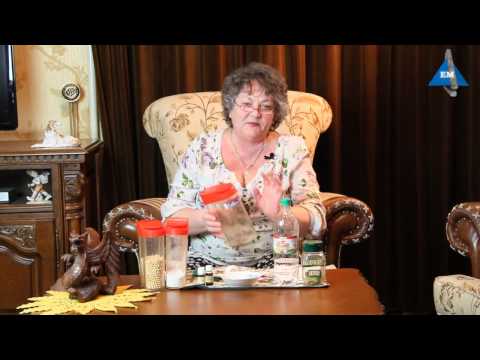

Watch this video on YouTube
How to get rid of a weevil on the site
Weevil on strawberries
The strawberry weevil is a long-probed beetle of black-gray color, the size of which is about 0.3 cm. In spring, individuals mate in flower buds, where the larvae develop later.
Today, there are many effective methods of combating weevils on strawberries, which can save up to 40 percent of the crop, even with a very severe damage. The fight against insects should be started as early as possible, this increases your chances of "winning".
In spring, when the air temperature is still uncomfortable for the beetle, the area where strawberries grow must be sprayed with one of the following solutions:
- 10 liters of water is combined with 1 tsp. iodine;
- dissolve three tablets from the weevil Intra-vir in a bucket of water.
The first time you need to spray the area when 5 or 6 days remain before flowering. The second treatment is carried out in the middle of the summer period. You can also spray strawberries and garden strawberries with such biological preparations as Namabact or Antonem-F. Until the last days of spring, bushes can also be treated with chemicals such as: Iskra-bio, Fitoverm or Akarin. The most powerful insecticides (for example, Actellik, Karbofos or Metaphos) are not recommended for processing strawberries.
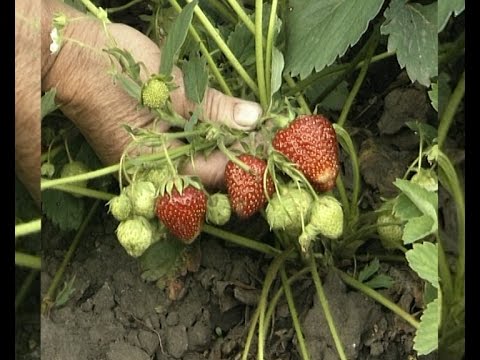

Watch this video on YouTube
Cherry weevil
Cherry weevil, also called cherry elephant, or cherry pipe-worm. It can harm not only cherries, but also the pest settles on plums, cherry plums, cherries, apricots and hawthorns. The length of such a greenish-golden beetle can vary from 0.55 to 1 centimeter, it has a purple metallic sheen. On the surface of the white larvae there are rare red hairs, their head is brown, and the mouth organ is brown. Such bugs damage the generative organs of stone fruit crops, while they do this in early spring before sap flow begins, as a result, the buds of the plants dry and fly around. Due to the invasion of such a pest, the gardener risks not only being left without a crop, but this can also cause the death of the trees themselves.
Experts advise to deal with the cherry weevil in all available ways, namely: preventive, folk, agrotechnical, biological and even chemical. For example:
- In autumn, tree trunks need to be freed from exfoliated old bark. All plant residues are destroyed, and the surface of the trunk is treated with a lime solution.
- The area near the tree, as well as the surface of the trunk circle, must be freed from loose leaves, which are then burned or sent to a compost heap.
- The soil in the near-trunk circle must be carefully dug up.
- During the swelling of the buds, white paper or cloth grows under the plant, on which pests are shaken off. Then they are destroyed.
- During the period of fruit ripening, it is necessary to regularly collect and destroy the volunteer, in this case the larvae from it will not be able to get to the ground.
- When the tree has faded, examine it carefully. If you find more than 8 pests, then spray the plant with any of the chemicals described above.
Plum weevil
The length of such a beetle is about 4.5 centimeters, it is painted in a bronze color with a metallic sheen. There are thick short hairs on the entire surface of the pest. Popularly, this insect is also called a copper pipe-runner, which is due to its appearance. It can settle on both plum and apricot, sweet cherry, sloe, cherry, apple, mountain ash, hawthorn and currant. Adults consistently damage buds, buds, flowers, pedicels, young fruits and foliage. The development of larvae takes place inside the fruit. They fight such an insect in the same way as with a cherry weevil. The most effective chemical agents in this case are pyrethroids and organophosphorus compounds, for example: Fufanon, Actellik or Bazudin.
Raspberry weevil
Raspberries are harmed by the same type of weevil as strawberries. The raspberries are harmed most by females. So, only one female during one season can damage about three dozen buds, arranging egg-laying in them. After 6-7 days, larvae emerge from the eggs; they eat the flower from the inside for 20 days. For the purpose of prevention, you need to take the same measures that were described in detail above. However, if the pest nevertheless appeared on raspberries, then in order to get rid of it, it is best to use folk remedies.
If there are a lot of pests on raspberries, then during budding process the plants with a solution of Taran. Before raspberries bloom and after harvest, it is recommended to treat them with insecticidal preparations such as Karbofos, Novaktion, Fufanon Expert or Iskra-M. Throughout the growing season, raspberry bushes from weevils can be sprayed with Alatar. Before using chemicals, read the instructions and do not forget about safety precautions.
Nut weevil
The nut weevil, which is also called the nut fruit, is a brown beetle, reaching from 0.7 to 1 centimeter in length. In the last days of April, females of such a weevil lay eggs in immature hazelnuts. After the larvae emerge from the eggs, they begin to eat away the pulp of the nuts, this can lead to the loss of half of the crop. Most often, such a pest settles on a nut if high humidity is observed for a long time, and the average daily temperature is about 19 degrees. In order to prevent the soil in the near-barrel circle, it is imperative to dig up to the depth of the shovel bayonet, also do not forget to collect and destroy the wormy fruits that have fallen to the ground in a timely manner. In order to get rid of such a pest, before the females begin to lay eggs, the tree must be sprayed over the ovaries with a solution of Actellik or Fufanon (2%).
Pine weevils
The large pine weevil, also called the spruce tree, is a dark brown beetle with a length of 0.7 to 1.4 centimeters. Adult insects harm those spruces and pines that are 3–6 years old; they eat up the bark to the sapwood on the trees. The resulting wounds merge together and are covered with resinous sap, as a result, the trunk becomes tarred, and this leads to the death of the tree. This type can also harm deciduous trees located near a spruce or pine forest, for example: alder, oak, birch, etc.
Also, 2 more types of weevils can harm conifers, namely: blue pine and pine. Pine weevil (pine elephant) is very dangerous for coniferous copses, they injure the tree bark, which leads to the death of plants. On the body of such a brown beetle, there is a pair of longitudinal stripes consisting of yellowish dots. The blue pine weevil has a blue tint. He gnaws small holes in young coniferous shoots, where he arranges egg-laying. Their larvae bite into wood, where they make passages and pupate. Conifers can suffer from both larvae and adult insects.
Rooks, crows, starlings, woodpeckers, magpies and jays are natural enemies of all weevil species, so it is recommended to attract them to your site. Other such insects feed on ktyri and ground beetles. To get rid of pests that have settled on conifers, chemical treatment will be required. To do this, during the period of mass settlement of pests, plants are sprayed with a solution of Metaphos, Karbofos, Actellik or another preparation of a similar action.
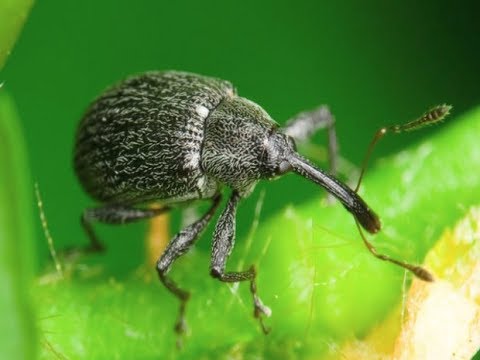

Watch this video on YouTube

